
The embodiment of man was not prepared
by the uprising of the human body.
The body rose up,
as the form became human.
Louis Bolk
Evolution of Dinosaurs
On the website of the American Nature Institute, I read an article by Steve Talbott about evolution, which referred to a phenomenological article about Dinosaurs by Martin Lockley. On this page you will find a summary of this article, with some additional factual information from Wikipedia and other websites (e.g. dinosaurs.about.com).
Threefoldness
Schad (Man and mammals, 1977) has developed the threefoldness of mammals (for more details see the pages on the Threefoldness of man and of mammals on this website). He distinguishes three orientations in mammals, thereby following Rudolf Steiner's three organ systems of man: the nerve-sense system, the metabolic-limb system and the rhythmic heart-lung system. Mammals are differentiated and can be classified according to these systems, so there are mammals with emphasis on the nerve-sense system, on the metabolic-limb system and on the heart-lung system. They thus complement each other. What the one mammal is not, the other is. Together, mammals can therefore be called a "super-organism".
The threefoldness is most clearly in the three most specialized groups: rodents, carnivores and ungulates. The body of rodents has posterior emphasis with long hind legs and a long tail, the body is posteriorly higher built. Rodents can jump well, too. Ungulates, on the other side, have anterior emphasis, the focus is on the muscular front legs, high withers and various head ornaments (horns, antlers). Rodents are laterally flattened, ugulates have a wide body. Carnivores have balance between front and hind body.
This physical pole is opposite to the physiological- or activity pole, which lies anterior in rodents in the nerve-sense system and posterior in ungulates in the metabolic-limb system.
- The small rodents observe much and respond quickly and strongly. They move quick over short distances and have a small range. The energy-rich food (seeds) is fast digested and give them short-term energy. They have a large species diversity.
- The large ungulates eat food, that is hard to digest and convert it into a large body. They are relatively quiet and move in herds over large distances. Species diversity is lower than in rodents. Nerve-sense like ungulates, like horses, camels and giraffes, have long necks to separate the attentive nerve-sense area from the dull metabolic-limb area.
- Carnivores have emphasis in the rhythmic heart-lung system, they live in the alternation of rest and hunting and take a middle position.
Rodents live short, ungulates long. The heartbeat of rodents is high and low for ungulates. Carnivores always take an intermediate position with their own characteristics defined by the dominance of the cardio-respiratory system.
At a lower level, within the groups, the same classification emerges using the same characteristics. Beavers and porcupines resemble ungulates in their diet and digestion of food, weasels resemble rodents in their nervous behavior and high back while moving. The many species of antelope are slender and the few species of cattle wide.
Rodents go on the forefoot and have a relatively large footprint, carnivores on their toes and ungulates walk on one or two tip-toes, the hooves, and have a small footprint.
In evolutionary time rodents occurred first, then came the carnivores and at last the ungulates emerged. There is an evolutionary trend of anteriorization of the physical pole and of posteriorization of the physiological pole.
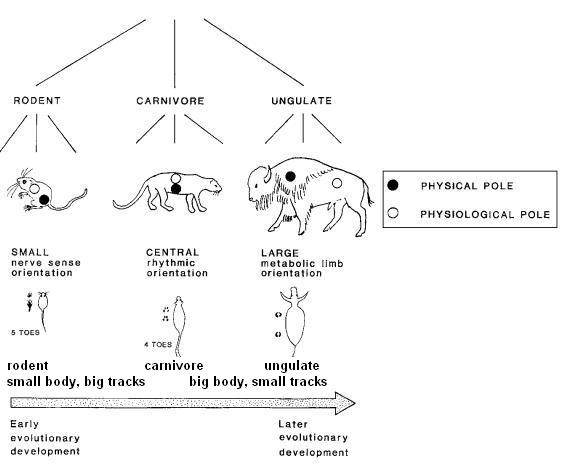
A summary of Schad's threefoldness of mammals
Dinosaurs 1: Saurischia (lizard-hipped)
The Saurischia include the Therapods and the Sauropodomorphs, which in turn are divided into the Prosauropods and the Sauropods. We will examine whether the principle of threefoldness also occurs in this group of Dinosaurs.
Theropods (beast-footed)
The exclusive bipedal Theropods are the only group of true carnivores, although some exceptions exist. They emerged in the late Triassic with major species diversity in the early Jurassic (see the figure at the top in the right column for the periods). At the end of the Cretaceous, they became extinct. Therapods are relatively small animals with a lateral (sideways) flattened body, a flattened skull and flattened teeth. The hind legs are large and the front legs small, sometimes extremely small. They have big eyes and relatively large brains, a short neck and a long tail. The joints of the legs are movable. They have nerve-sense orientation, the body has posterior emphasis. Some large theropods have ornaments on the nose.
Prosauropods (pre-lizard-footed)
The relatively small and primitive Prosauropoda arose at the end of the Triassic. At the beginning of the Jurassic many species occured and then they became extinct. It is not clear whether they were carnivores or herbivores. They were two- or four-legged.

A skeleton of Apatosaurus of 30 meters long
Sauropods (lizard-footed)
Sauropods are very large animals with long necks. Even small representatives were 6 meters long. More than 30 meters was quite common and many species weighed up to 100 tons. They were herbivores and quadruped. They arose in the late Triassic, many species occured in the late Jurassic and at the end of the Cretaceous they became extinct. The legs were like pillars and the joints of the legs were not flexible. The skull and teeth were less flattened. Some species had ornaments on the nose or forehead, or shields on their body. The long neck gives distance between the nerve-sense area of the head and the metabolic-limb area of the body, so they are not immersed in the dullness of the metabolic processes.
When Sauropods and Theropods become bigger and more specialized, the emphasis of the body is more anterior. Theropods become a bigger head, and the neck and front legs get shorter. Sauropods become a smaller tail and the small head gets higher by extention of the neck and longer front legs. Anterior emphasis thereby has two forms: a large head, short neck and short forelimbs or a small head, long neck and long front legs.

Classification of the Saurischia with body contours; for each group left early forms, right late. Early species of Theropods have posterior emphasis, later ones have a big head. Sauropods have anterior emphasis from the very start. The tail beomes shorter and the anterior part of the body (trunk, neck, legs) increases in size.
Dinosaurs 2: Ornithischia (bird-hipped)
The Ornithischia comprise the Thyreophorans and the Cerapods, which in turn are divided into the Ornithopods and the Marginocephalians.
Thyreophorans (shield bearers)
Thyreophorans are the Dinosaurs with shields, plates and spikes, that are rhythmically arranged. Early types were relatively small with shields, a long tail and short legs. The later, larger species had distinctive plates and spines and paired weapons or clubs at the end of their tail. Besides the group of the early species, two distinct groups: the Stegosaurs and Ankylosaurs existed.
The Stegosaurs had a laterally flattened body, long hind legs and a long skull. Ankylosaurs had a horizontal and wide body and the head was horizontal and wide, too, sometimes with lateral horns on the head. They had short hind legs. All species had teeth, no molars. The Stegosaurs flourished in the Jurassic and declined in the Cretaceous. Ankylosaurs had their heyday in the Cretaceous.
Ornithopods (bird-footed)
Ornithopoda show a development from small, bipedal animals from the early Jurassic to large beasts known as Iguanodon and Hadrosaurus in the Cretaceous. The hind legs are longer than the front legs and sometimes there are ornaments on the forehead.
Marginocephalians (fringed-heads)
The herbivorous Marginocephalians emerged only in the middle of the Cretaceous. Early representatives were small and bipedal and had a long tail. The later, horned species like Triceratops were four-footed animals with a short tail and a large head with a "fringe" and paired ungulate-like horns. The later species had no stones in their stomachs to grind food, but adjustments to the digestive tract.
Early species of Ornithopodans and Marginocephalians had teeth, late species had big molars with which they could grind hard plant material.

Classification of the Ornithischia. In time, Thyreophorans show three groups: the earliest animals, the Stegosaurs and the Ankylosaurs. Early bipedal species of Ornithopodans and Marginocephalians are on the left, and the later, more specialized species on the right hand side.
Conclusions
Saurischia and Ornithischia can be classified in a threefold way in the same manner and with the same characteristics as mammals.
Both contain small, active, energy-rich foods eating animals with posterior emphasis (Theropods and Thyreophorans, big, slow, herbivorous animals with a large body and anterior emphasis (Sauropods and Marginocephalians), and a third group with intermediate characteristics (Prosauropods and Ornithopods). So both groups have nerve-sense animals, metabolic-limb animals and heart-lung animals.
Within the groups it is apparent that over time an anterior shift of the body mass took place, together with a shift to a larger body and to herbivory. First the nerve-sense animals emerge, followed by the heart-lung animals and as last the metabolic-limb animals arise.
From the shape of the body to a part
The limbs
The phenomenon of anteriorization should not only be visible in the shape of the body, but also in parts such as the limbs. In the series of rodents, carnivores and ungulates, the upper leg becomes relative larger to the lower leg and the metatarsals increase relative to the toes. This is reflected in Dinosaurs too. There also the more internal parts increase in size over time.
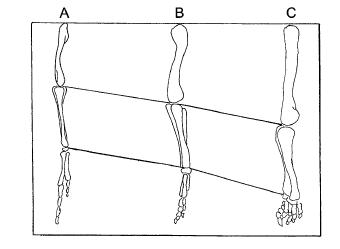
Relative leg lengths of A. a Theropod, B. a Prosauropod and C. a Sauropod. In the course of evolution, the proximal upper leg increases in size and the distal feet decreases.
This phenomenon is also visible in the jaw (the limbs part of the skull) and the teeth. In rodents, the emphasis is on the incisors, in carnivores on the canines and in ungulates on the molars. As large ungulates, Cerapoda lose their teeth. In time, the emphasis goes to the more inward laying molars. Remarkably is that Brachiosaurus with its long neck does have chisel-shaped teeth, just as a horse.
Tracks
Besides bones also tracks of dinosaurs are found. As it is not clear which track belongs to which species of which parts of the skeleton are found, the tracks are given different names. But it can be determined to which group the tracks belong.
The tracks of both groups of dinosaurs show an anterior shift. Both groups (Saurischia and Ornithischia) emerged as small, unspecialized animals with predominantly three-toed tracks, with the legs close together and a small trackway. In the course of time increasingly more specialized quadrupeds with larger front legs emerged. They had more toes (4 or 5) and showed a wider trackway. This shift from a narrow to a wide trackway and from tracks of the hind legs to tracks of front- and hind legs, is accompanied by a shift of body weight from posterior to anterior. First, the posterior part of the feet gets bigger and slowly this enlargement shifts to the anterior part, when the animals become more herbivorous and get more metabolic-limb character.
A comparison of the fossil record of tracks shows that, as in rodents, there are many kinds of Theropods with a small range (many different tracks (many species) in a small area (many movements of active animals, low dispersion)). And like ungulates, Sauropods are gregarious migrating animals that cover great distances (few different tracks (few species) over a large area (big dispersion, low activity)).
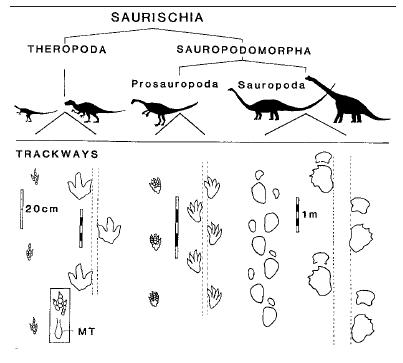
Tracks of Saurischia
Feet of Theropods (pictured are Grallator and Megalosauripus, see the right column, too) have three separate toes, Prosauropods (Otozoum, two species) and Sauropoda (right: Brontopodus) have four or five. They have the toes more included in the fleshy foot. Sauropods have their front- and hind legs depicted, the other two groups only the hind legs.
Patterns
As can be seen, both groups of Dinosaurs show a trend of small, narrow, elongated, bipedal animals with posterior emphasis (large hind legs, long tail) to large, wide, quadruped animals, with anterior emphasis (high shoulders, large head, long front legs). This goes along with physiological and behavioral shifts from a focus on the nerve-sense area to the metabolic-limb area and a shift from a carnivorous to a herbivorous diet. This applies to both Saurischia and Ornithischia, but also for all groups within it, except for the Theropods (which do not become quadruped and usually stay carnivore, but do develop a huge head). Also, Pterosaurs and other Archosaurs show the outlined development. History seems to repeat itself, but the development is always slightly different.
Iteration
Theropods, Sauropodomorphs, Thyreophorans and Cerapods partially overlap in time and have their heyday in succession, respectively, in the early Jurassic, the late Jurassic, the early Cretaceous and the late Cretaceous. The later, large, herbivorous representatives of each successive group are further away from the original bipedal, carnivorous animals, and closer to the ungulates. This is particularly evident for the large grinding molars and the large head ornaments of the Ornithopods and the Cerapods, which show an appearance that is a prelude to that of the unrelated odd-toed and even-toed ungulates. There is an iteration on a ever "higher" (more mammalian-like) level.
Similarities between Ornithischians and ungulates
Ornithischia and ungulates are both focused on the metabolic-limb area. Like Ornithischians, ungulates start with small, three-toed animals, in the early Tertiary followed by the odd-toed ungulates (horses, tapirs and rhinos) and in the late Tertiary and Quaternary, the even-toed ungulates (including deer, antelope, sheep and cattle) came to blosom.
In both Dinosaurs and ungulates it is remarkable that their ancestors had about the same size and had three toes. Ungulates, however, have shorter, more segmented and fleshy feet. The large three-toed ungulates and dinosaurs, all have shields on their body or a thick skin and head ornaments placed in the middle, which can be seen as a reflection of the important, central, third toe. In the course of evolution we see:
- an anterior shift of the body mass
- an increase in the number of toes of the largest animals
- a lengthening of the more central parts of the body such as the upper legs and the molars.
The head ornaments move in the course of evolution to a more anterior position. Of the odd-toed animals Stegosaurus has spines on its tail and a row of plates on its backbone, the Ornithopods Lambeosaurus and Hadrosaurus have a crest on the forehead and the rhinoceros has one or two horns in a row at the tip of its nose.
A trend, but then paired, that can also be seen with the even-toed animals: Ankylosaurs have heavy body plates and paired horns on the sides of the body, Cerapods have wide fringes and paired horns on the head and even-toed ungulates have paired horns or antlers but no fringes or shields. It is the same process that we see as the convolutions of a spiral.
It are similar morphological processes that are visible in both the bison and Triceratops with their wide, low kept, horned heads and the horse and Hadrosaurus with their elongated skull and large grinding molars.
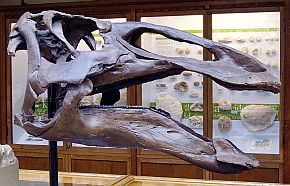
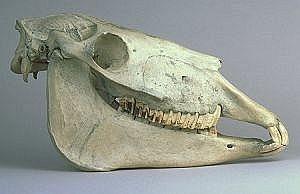
The long skulls of a relative of Hadrosaurus (Edmontosaurus) and a horse; both have a large skull and long grinding molars.
The horned Cerapoda had the biggest heads of all dinosaurs and they lived at the same time as Tyrannosaurus rex, being the Theropod with the largest head. Also, the Sauropods and the mammal-like reptiles had excessive anterior emphasis before they became extinct. The question is whether this is a coincidence.

The evolution of Ornithischia (Thyreophorans and Cerapods) and ungulates can be displayed in three cycles, which show similar changes over time (from left to right). From bottom to top, the iteration that the groups show can be clearly seen. There is a shift in emphasis from posterior to anterior in odd- and even-toed animals, and they look ever more like ungulates. That process and development seem to be independent of linear time.
Conclusions
Evolution Theory
The changes in body shape of the different groups are remarkably similar. Therefore there may be doubts about the idea that:
- Organisms adjust body parts to the environment (e.g. the long neck of the giraffe to eat from the top of trees or the horns of cattle to fight) and
- that evolution emerges by random mutations on which natural selection works.
When a Dinosaur develops a larger head, one-dimensional explanations like "to fight" are not appropriate because many changes occur at once. Also, that statement is not valid, because we see big heads repeatedly develop in all groups from small Theropods to large Cerapods with Triceratops and Rhinoceros as extreme examples.
Based on the data of dinosaurs, other conclusions can be drawn:
- All body parts change simultaneously as part of a complex organic process. Simple cause and effect explanations are too simple and insufficient to explain these complex processes. They provide only a superficial understanding.
- The evolution of species is a process, at least in part, that has its own momentum and direction, and reflects major changes that affect many species.
Extinction
Thyreophorans, Cerapods and ungulates show three consecutive cycles of a shift from posterior to anterior. It is striking that the great extinction at the end of the Mezozoicum came when horned dinosaurs like Triceratops had reached their maximum head size and had an extreme anterior emphasis. When such a development is repeatedly followed by the extinction of an entire animal group this implies:
- that explanations by external causes such as climate change or a meteor hitting, are misleading or at best incomplete and
- that extinction is part of the life cycle of an animal group, considered as a "super-organism"
- and that extinction is an inherent part of live.
Based on:
- Lockley, Martin G. (2007). "The Morphodynamics of Dinosaurs, Other Archosaurs, and Their Trackways: Relationships Between Holistic Insights into Feet, Limbs, and the Whole Body," SEPM Special Publication No. 88 (Society for Sedimentary Geology), pp. 27-51.
Drawings from this article (left column) with permission of the author, images right column are mainly from Wikipedia and dinosaurs.about.com.

Part of the geological timetable with the periods used on this page
Saurischia
Theropods
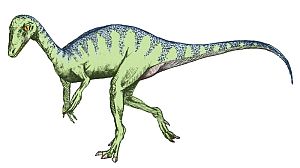
Eoraptor, 1 meter long, a weight of 10 kilos, one
of the first Dinosaurs, walked on its hind legs
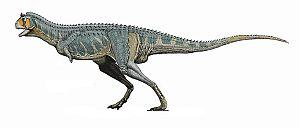
Carnotaurus, 7 meters long and 1 ton heavy, tiny arms and two triangular horns above the eyes, a true carnivore

Tyrannosaurus rex, a late species, about 12 meters long and 6 meters high, weighed 7 ton, big head,
its short arms could not reach its mouth, was probably a scavenger
Prosauropods

Plateosaurus, 10 meters long, weighing 1 ton, powerful hind legs and short front legs, long neck and tail
Sauropods

Apatosaurus (Brontosaurus), 30 meters long and 3 meters high, weight 40 tons, could be up to 100 years old, a small head with sharp teeth

Brachiosaurus, 15 meters high and 90 tons, looked like a giraffe with its long neck and long front legs, chisel-shaped teeth and a small head
Ornitischia
Thyreophorans

Scutellosaurus, a primitive species, 1.20 meters long, weighed 10 pounds, bipedal, skin covered
with scales, very long tail
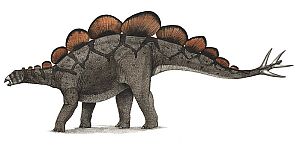
Hesperosaurus (Stegosaur), 6 meters long, longer hind than front legs, a row of shields on the backbone and four spines on the tail

Saicharia (Ankylosaur), 6 meters long, the back covered with plates with spines, the tail ends in
a club
Ornithopods

Tenontosaurus, up to 7 meters long and 2 tons, a long tail and long hind legs, plant eater

Iguanodon; certainly 10 meters long and weighed 3 tons, long hind legs, walked on all four
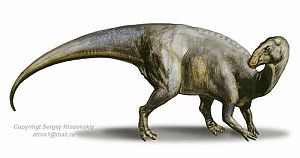
Hadrosaurus, 12 meters long, 7 tons, long, flat skull, herbivore, also called "duckbill" Dinosaur
Marginocephalia

Anchiceratops (Cerapoda), 6 meters long and 2.5 meters high, 2 tons, two big and a small horn and
a large collar

Centrosaurus, 6 meters long, a horn on its nose, which could be bent forward or backward and
a big, tall, radiant collar
Tracks
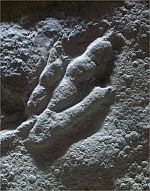

Grallator and Megalosauripus, both Theropods
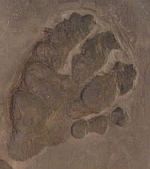
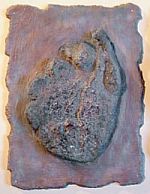
Otozoum, a Prosauropoda and Brontopodus, a Sauropoda
Odd-toed animals compared
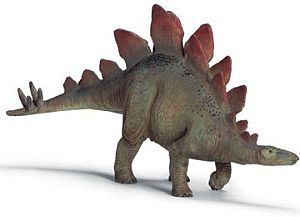
Stegosaurus, 9 meters long, hind legs much longer than front legs, a small head, plates on the backbone up to 90 cm high

Parasaurolophus (Ornithopoda), 12 meters long, weight 1 tons, a large comb (up to 1.80 meters)
on the head, long hind legs

Black rhinoceros (ungulates), up to 4 meters long and 2 meters high and 3.5 tons, two keratin horns behind each other on the nose
Even-toed animals compared

Ankylosaurus, 6 meters long and 1.5 meters wide,
4 tons, wide built, small round head and a club on its tail bone

Triceratops, about 12 meters long, of which 1/3 is the head, weighed 6 to 12 tons, solid, low held head, three keratin horns and a big collar

Bison (Artiodactyla), up to 800 kilos, 3 meters long and 2 meters high, short horns sidewards on the head, heavy head is kept low

Triceratops skull (1/3 of body length), two long horns curved forward (or backward) and a little
one on the nose, a wide collar

Skull of a rhinoceros, which is about 1/3 of the
body length, with two keratin horns
